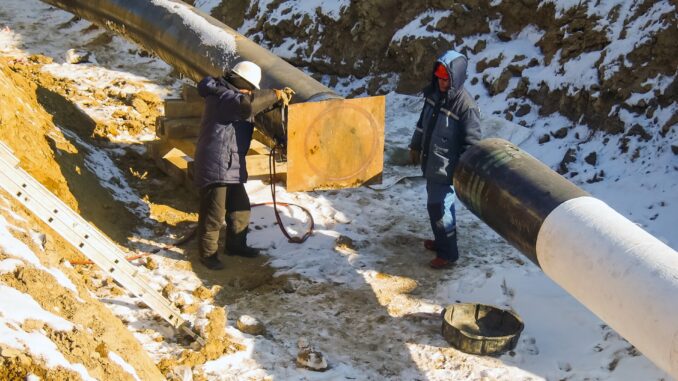
- Boosting domestic consumption and diversifying exports underpin Moscow’s new energy strategy as the EU seeks to phase out Russian gas imports by 2027.
- Both will require major investments, and domestic sales will bring lower returns to Gazprom.
- Moscow may need to find a new home for roughly 130 billion cubic meters or more — assuming some EU slippage and continued Turkish purchases.
Russia is minimizing gas exports to Europe as part of a pressure campaign on Brussels amid the war in Ukraine. A full cutoff right now brings revenue and leverage risks to Moscow. But longer term, Russia needs a plan to replace sales to the EU, even if its expectation is that Brussels will fail to reach its ambitious 2027 target.
It’s speculation to predict precise volumes of exports to Europe in the long term, said Sergei Kapitonov, a gas analyst at Skoltech Project Center for Energy Transition and ESG in Moscow. But with that in mind, Turkey, the Balkan states and in the EU, Hungary and possibly Austria and Germany, could still be using Russian gas even after 2030 due to economic reasons — with Turkey probably the only less politically dependent market, he noted. And if and when the conflict resolves, Russia may use its short-term instruments to stay on the EU market as a supplier of last resort in times of gas deficit or price hikes.
The EU’s 150 Bcm of imports last year accounted for 30% of Gazprom’s and 20% of Russia’s production — or nearly 70% of pipeline gas exports and some 60% of Russia’s total gas exports, including LNG. Turkey separately imported some 25 Bcm of Russian gas in 2021, accounting for the bulk of Gazprom’s roughly 30 Bcm in non-EU westward exports. Toward that end, according to the Russian oil and gas veteran, former Energy Minister Yuri Shafranik, Europe could still be taking 35 Bcm-45 Bcm annually in 2030. That could leave some 130 Bcm or more seeking alternative markets.
A new 2050 energy strategy is expected to be drafted by mid-September, centering on developing the domestic gas market and building out alternative export infrastructure. Replacing European exports is critical to filling state coffers: Gazprom revenues were at a record high of $10 billion per month in the first half of 2022. It is also critical to extending the lives of mature gas fields in West Siberia, around which cities were built in the region in the 1970s.
Domestic Potential
In the near term, domestic demand hardly offsets the drop in gas exports to Europe and will likely decline because of an expected economic slowdown amid Western sanctions. Metals, automotive and other industries are already feeling the pressure of restricted export and import opportunities, which will contribute to this year’s expected 5% decrease in power generation, a large consumer of natural gas. That said, Moscow intends to spend 800 billion rubles ($13 billion) over 2021-25 on expanding the gas grid, including in frontier eastern regions with historically low gas penetration rates.
Based on Gazprom estimates last year, Russia had hoped to increase domestic consumption by at least 18.6 Bcm/yr by 2025 through the expansion of the gas grid. Moscow now seeks to accelerate the grid expansion project, Deputy Prime Minister Alexander Novak has said. With new industrial consumers, sparsely populated east Siberian and far eastern regions might consume up to 30 Bcm/yr in the long term, he said. The Murmansk region in northwestern Russia, which also lacks gas pipelines, might add 8 Bcm/yr to consumption if it switches from fuel oil to gas, according to participants at a recent meeting of the State Duma energy committee.
Iran’s booming domestic gas consumption shows what’s achievable under sanctions, but “Russia’s domestic gas market is a well-balanced one with only a few potential points of growth,” Kapitonov noted. These may include the expansion of LNG use for bunkering in the Arctic, gasification of coal-dependent cities and possibly more use of gas in steelmaking sector and petrochemicals, he said, although sanctions could constrain gas use in technology-dependent industries such as petrochemicals. Should that industry take off, it could potentially replace some $30 billion per year of petrochemicals imports, Shafranik said.
Revenue Pain in the Picture
New sales into the domestic market will hardly generate similar revenues to those in Europe, which has traditionally been a higher-margin market. Gazprom’s exclusive right to export pipeline gas at higher prices has been widely seen as a reward for the socially oriented mission to ensure stable supply at regulated and relatively low prices at home. Indeed, with low gas prices for residential consumers having that social component in Russia, unpopular steps to raise prices at home are not expected in the short- to medium-term period, notes Kapitonov.
Taking that into account, Gazprom instead might get the right to set flexible prices for industrial consumers at home, the State Duma energy committee suggested. While this would help replenish the coffers of Gazprom, the Kremlin’s cash cow, it could also result in higher costs for its clients and spur inflation.
China in the Driving Seat
Russia has two pipeline contracts with China for a total of 48 Bcm/yr — with exports this year to reach 15 Bcm/yr on the 38 Bcm/yr Power of Siberia line. Gazprom says it can supply up to 130 Bcm/yr in the future. But some experts believe that although Beijing might be interested in cheap Russian piped gas, it might be cautious about deepening ties with sanctions-hit Russia. Chinese investment in Russia under its Belt and Road scheme fell to zero in the first half of this year, while Chinese lenders could struggle to recoup their investments in Russia as planned.
China will also likely use Russia’s growing isolation as leverage in gas price talks in any new contracts with Russia, further reducing margins on expensive export pipeline projects. February’s 10 Bcm/yr supply deal, on which details are scant, was likely pushed through by politics and Russia’s need to demonstrate it has friends outside the West.
Russia is meanwhile sticking to plans to expand LNG exports to up to 140 million tons/yr by 2035, up from 30 million tons/yr currently. But these look unrealistic amid EU sanctions banning the export and transit of key liquefaction equipment, while foreign engineering contractors, including Technip Energies and Linde, are withdrawing from Russian projects. Moscow has yet to develop its own LNG technology and competence at scale.
For now at least, revenue pain is a future worry. Gazprom is currently exporting at its lowest levels to Europe since the late 1970s-early 1980s but reeling in historically high earnings, Kapitonov pointed out. But longer term, Russia’s gas will need to find non-EU markets at scale. In contrast to the rerouting of oil exports, these alternative gas markets will require significant investment to reach — and won’t likely be as lucrative.
Source: Energyintel.com



